This pub bears the name of the old George Inn which traded on this site from at least the 15th century to the late 18th century.
Prints and text about The George.
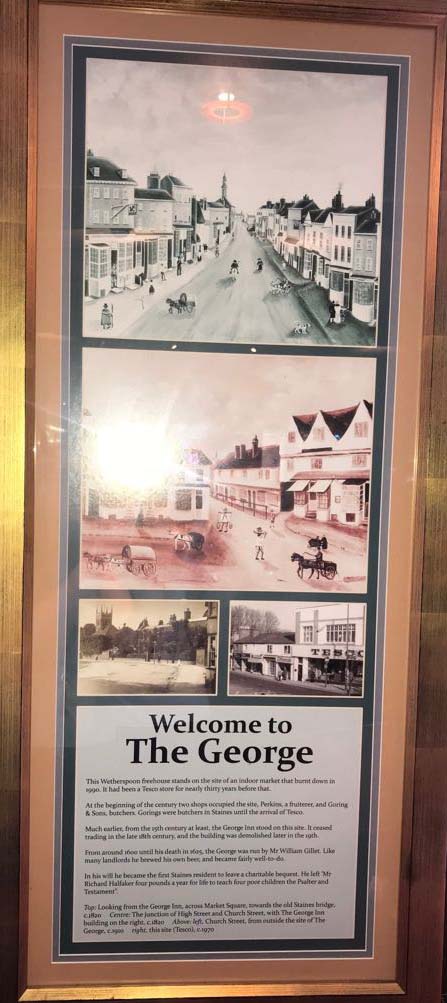
The text reads: This Wetherspoon freehouse stands on the site of an indoor market that burnt down in 1990. It had been a Tesco store for nearly thirty years before that.
At the beginning of the century two shops occupied the site. Perkins, a fruiterer, and Goring & Sons, butchers. Goring’s were butchers in Staines until the arrival of Tesco.
Much earlier, from the 15th century at least, the George Inn stood on this site. It ceased trading in the late 18th century, and the building was demolished later in the 19th.
From around 1600 until his death in 1625, the George was run by Mr William Gillet. Like many landlords he brewed his own beer, and became fairly well-to-do.
In his will he became the first Staines resident to leave a charitable bequest. He left “Mr Richard Halfaker four pounds a year for life to teach four poor children the Psalter and Testament.”
Top: Looking from the George Inn, across Market Square, towards the old Staines bridge, c1820
Centre: The junction of High Street and Church Street, with The George Inn building on the right, c1820
Above left: Church Street, from outside the site of The George, c1910
Right: this site (Tesco), c1970.
Photographs and text about Christine Keeler.
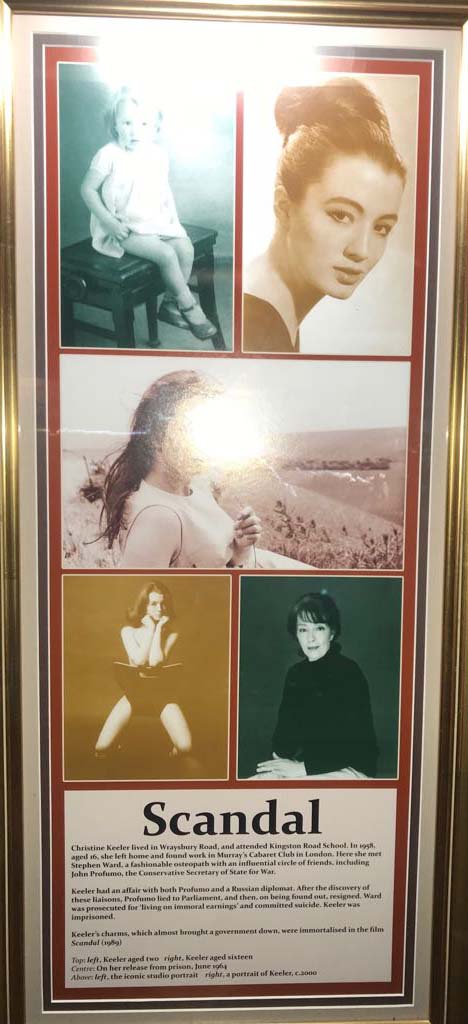
The text reads: Christine Keeler lived in Wraysbury Road and attended Kingston Road School. In 1958, aged 16, she left home and found work in Murrays’ Cabaret Club in London. Here she met Stephen Ward, a fashionable osteopath with an influential circle of friends, including John Profumo, the conservative secretary of state for war.
Keeler had an affair with both Profumo and a Russian diplomat. After the discovery of these liaisons, Profumo lied to Parliament, and then, on being found out, resigned. Ward was prosecuted for ‘living on immoral earnings’ and committed suicide. Keeler was imprisoned.
Keeler’s charms, which almost brought a government down, were immortalised in the film Scandal (1989).
Top: left, Keeler aged two
Right: Keeler aged sixteen
Centre: On her released from prison, June 1964
Above, left: The iconic studio portrait
Right: A portrait of Keeler, c2000.
Photographs and text about Alan Ayckbourn.
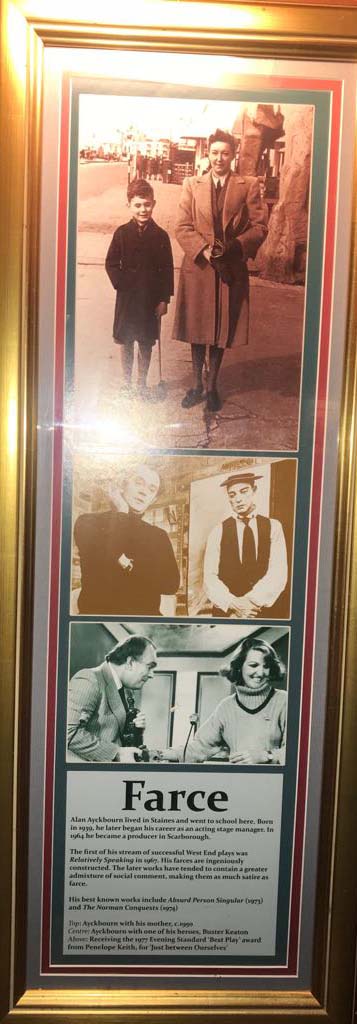
Alan Ayckbourn lived in Staines and went to school here. Born in 1939, he later began his career as an acting stage manager. In 1964 he became a producer in Scarborough.
The first of his stream of successful West End plays was Relatively Speaking in 1967. His farces are ingeniously constructed. The later works have tended to contain a greater admixture of social comment, making them as much satire as farce.
His best known works include Absurd Person Singular (1973) and The Norman Conquests (1974).
Top: Ayckbourn with his mother, c1950
Centre: Ayckbourn with one of his heroes, Buster Keaton
Above: Receiving the 1977 Evening Standard Best Play award from Penelope Keith, for Just Between Ourselves.
Photographs and text about Ranjitsinhji.
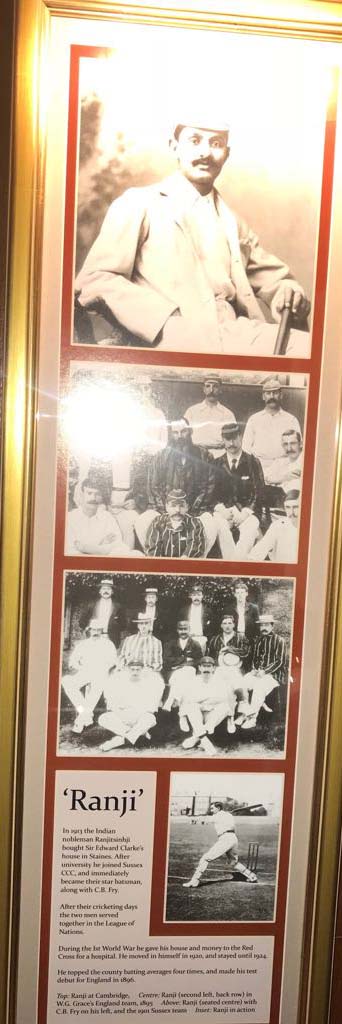
In 1913 the Indian nobleman Ranjitsinhji bought Sir Edward Clarke’s house in Staines. After university he joined Sussex CCC, and immediately became their star batsman, along with CB Fry.
After their cricketing days the two men served together in the League of Nations.
During the 1st World War he gave his house and money to the Red Cross for a hospital. He moved himself in 1920, and stayed until 1924.
He topped the country batting averages four times, and made his test debut for England in 1896.
Top: Ranji at Cambridge.
Centre: Ranji (second left, back row) in WG Grace’s England team, 1895
Above: Ranji (seated centre) with CB Fry on his left, and the 1901 Sussex team
Inset: Ranji in action
Photographs and text about fire services.
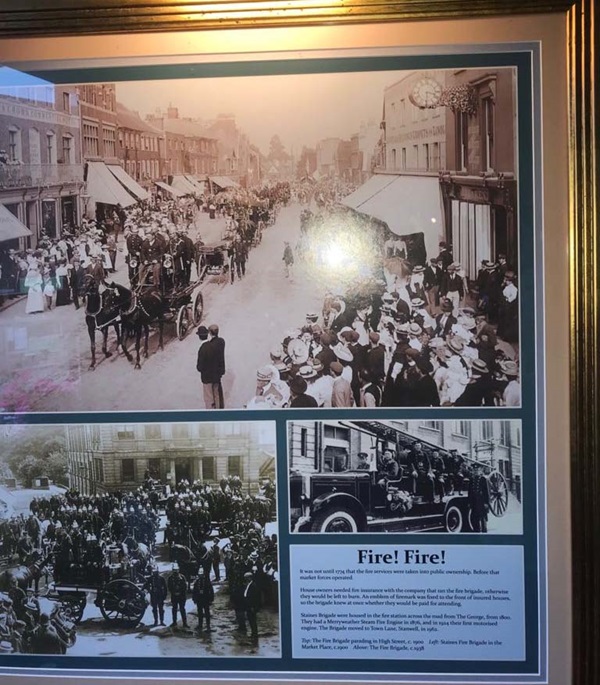
The text reads: It was not until 1774 that the fire services were taken into public ownership. Before that market forces operated.
House owners needed fire insurance with the company that ran the fire brigade, otherwise they would be left to burn. An emblem of fire mark was fixed to the front of insured houses, so the brigade knew at once whether they would be paid for attending.
Staines Brigade were housed in the fire station across the road from The George, from 1800. They had a Merryweather Steam Fire Engine in 1876, and in 1924 their first motorised engine. The Brigade moved to Town Lane, Stanwell, in 1962.
Top: The Fire Brigade parading in High Street, c1900
Left: Staines Fire Brigade in the Market Place, c1900.
Above: The Fire Brigade, c1938.
Photographs, an illustration and text about the Swan Uppers.
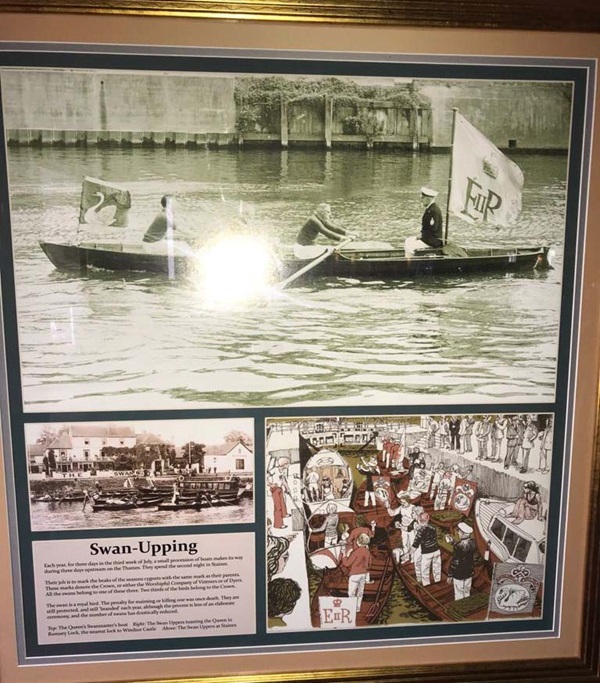
The text reads: Each year, for three days in the third week of July, a small procession of boats makes its way during three days upstream on the Thames. They spend the second night in Staines.
Their job is to mark the beaks of the season, with the same mark as their parents. These marks denote the Crown, or either the Worshipful Company of Vintners or of Dyers. All the swans belong to one of these three. Two thirds of the birds belong to the Crown.
The swan is a royal bird. The penalty for maiming or killing one was once death. They are still protected, and still ‘branded’ each year, although the process is less of an elaborate ceremony, and the number of swans has drastically reduced.
Top: The Queen’s Swanmaster’s boat
Right: The Swan Uppers toasting the Queen in Romney Lock, the nearest lock to Windsor Castle
Above: The Swan Uppers at Staines
Prints and text about Staines Bridge.
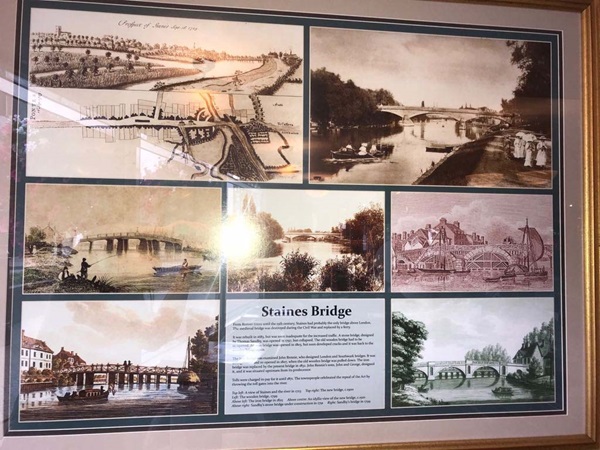
The text reads: From Roman times until the 15th century. Staines had probably the only bridge above London. The medieval bridge was destroyed during the Civil War and replaced by a ferry.
It was rebuilt in 1683, but was soon inadequately increased traffic. A stone bridge, designed by Thomas Sandby, was opened in 1807, when the cold wooden bridge was pulled down. The iron bridge was replaced by the present bridge in 1832. John Rennie’s sons, John and George, designed it, and it was situated upstream from its predecessor.
Tolls were charged to pay for it until 1871. The townspeople celebrated the repeal of the Act by throwing the toll gates into the river.
Top left: A view of Staines and the river in 1723
Top right: The new bridge, c1900
Left: The wooden bridge, 1799
Above left: The iron bridge in 1825
Above, centre: An idyllic view of the new bridge, c1910
Above right: Sandby’s stone bridge under construction in 1791
Right: Sandby’s bridge in 1799.
A print and text about Sir Edward George Clark.
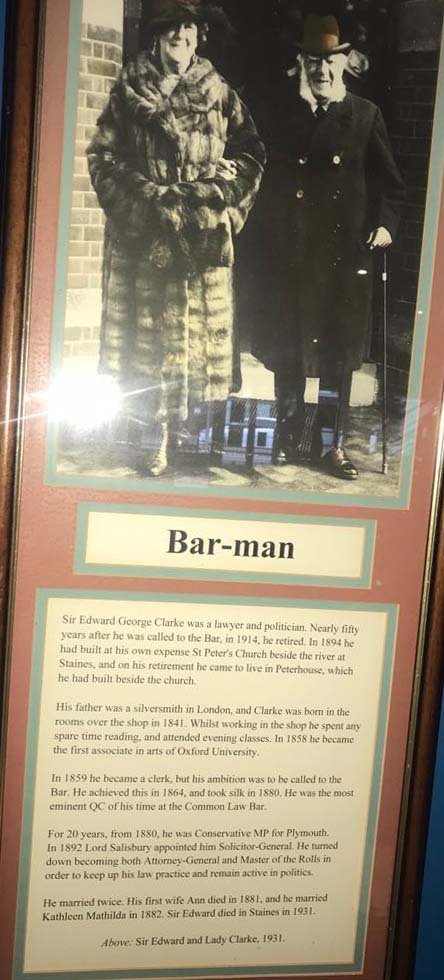
The text reads: Sir Edward George Clarke was a lawyer and politician. Nearly fifty years after he was called to the Bar, in 1914, he retired. In 1894 he had built at his own expense St Peter’s Church beside the river at Staines, and on his retirement, he came to live in Peterhouse, which he had built beside the church.
His father was a silversmith in London, and Clarke was born in the rooms over the shop in 1841. Whilst working in the shop he spent any spare time reading, and attended evening classes. In 1858 he became the first associate in arts of Oxford University.
In 1859 he became a clerk, but his ambition was to be called to the Bar. He achieved this in 1864, and took silk in 1880. He was the most eminent QC of his time at the Common Law Bar.
For 20 years, from 1880, he was Conservative MP for Plymouth. In 1892 Lord Salisbury appointed him Solicitor-General. He turned down becoming both Attorney General and Master of the Rolls in order to keep up his law practice and remain active in politics.
He married twice. His first wife Ann died in 1881, and he married Kathleen Mathilda in 1882. Sir Edward died in Staines in 1931.
Above: Sir Edward and Lady Clarke, 1931.
Prints and text about the railway in Staines.
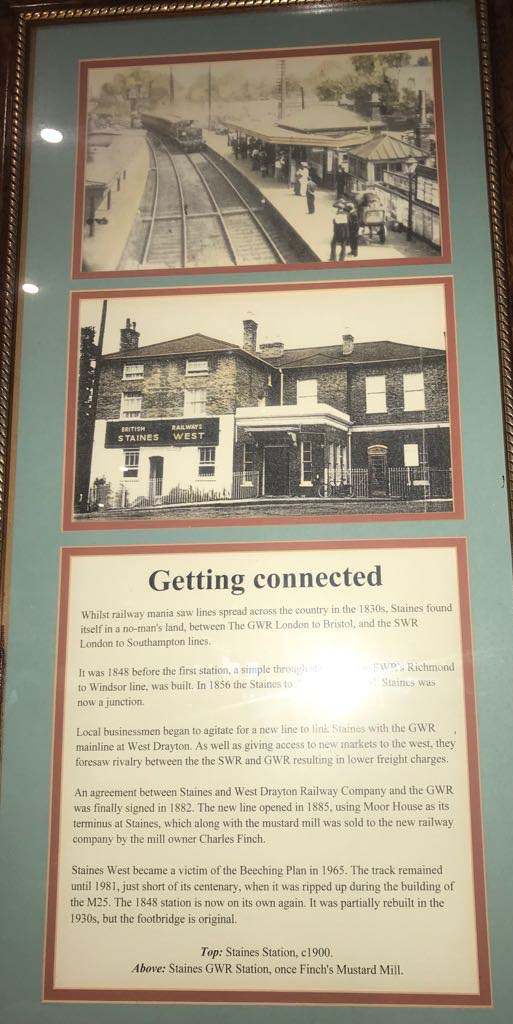
The text reads: Whilst railway mania saw lines spread across the country in the 1830s, Staines found itself in no-man’s land, between The GWR London to Bristol, and the SWR London to Southampton lines.
It was 1848 before the first station, a simple through station on the SWR’s Richmond to Windsor line, was built. In 1856 the Staines to Ascot line opened. Staines was now a junction.
Local businessmen began to agitate or a new line to link Staines with the GWR mainline at West Drayton. As well as giving access to new markets to the west, they foresaw rivalry between the SWR and GWR resulting in lower freight charges.
An agreement between Staines and West Drayton Railway Company and the GWR was finally signed in 1882. The new line opened in 1855, using Moor House as its terminus at Staines, which along with the mustard mill was sold to the new railway company by the mill owner Charles Finch.
Staines West became a victim of the Beeching Plan in 1965. The track remained until 1981, just short of its centenary, when it was ripped up during the building of the M25. The 1848 station is now on its own again. It was partially rebuilt in the 1930s, but the footbridge is original.
Top: Staines Station, c1900
Above: Staines GWR Station, once Finch’s Mustard Mill.
Photographs and text about Staines’s Linoleum.
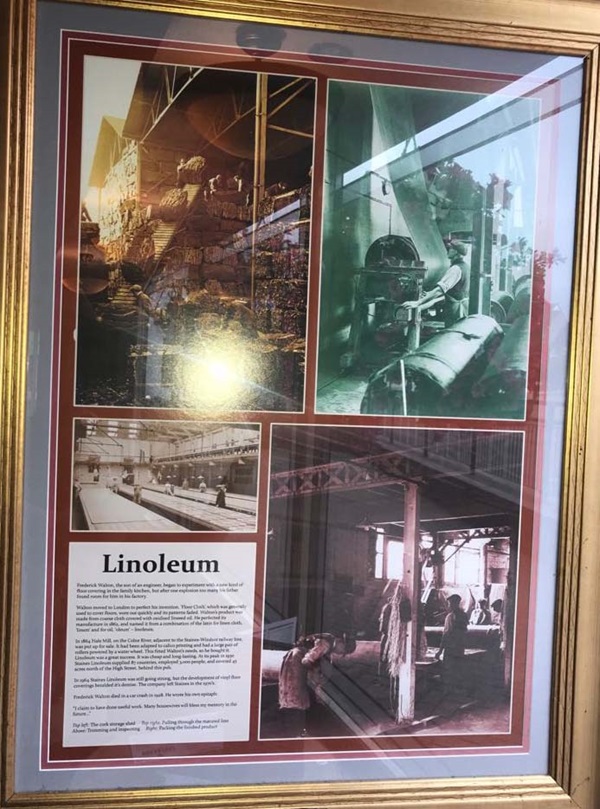
The text reads: Frederick Walton, the son of an engineer began to experiment with a new kind of floor covering in the family kitchen, but after one explosion too many, his father found room for him in his factory.
Walton moved to London to perfect his invention. ‘Floor Cloth’, which was generally used to cover floors, wore out quickly and its patterns faded. Walton’s product was made from coarse cloth covered with oxidised linseed oil. He perfected its manufacture in 1862, and names it from a combination of the Latin for linen cloth, ‘linum’ and for oil, ‘oleum’ – linoleum.
In 1864 Hale Mill, on the Colne River, adjacent to the Staines-Windsor railway line, was put up for sale. It had been adapted to calico printing and had a large pair of rollers powered by a water wheel. This fitted Walton’s needs, so he bought it. Linoleum was a great success. It was cheap and long-lasting. At its peak in 1930 Staines Linoleum supplied 87 countries, employed 3,000 people, and covered 45 acres north of the High Street, behind this pub.
In 1964 Staines Linoleum was still going strong, but the development of vinyl floor coverings heralded its demise. The company left Staines in the 1970’s.
Frederick Walton died in a car crash in 1928. He wrote his own epitaph: “I claim to have done useful work. Many housewives will bless my memory in the future…”
Top left: The cork storage shed
Top right: Pulling through the matured lino
Above: Trimming and inspecting
Right: Packing the finished product.
Photographs of roads in Staines.
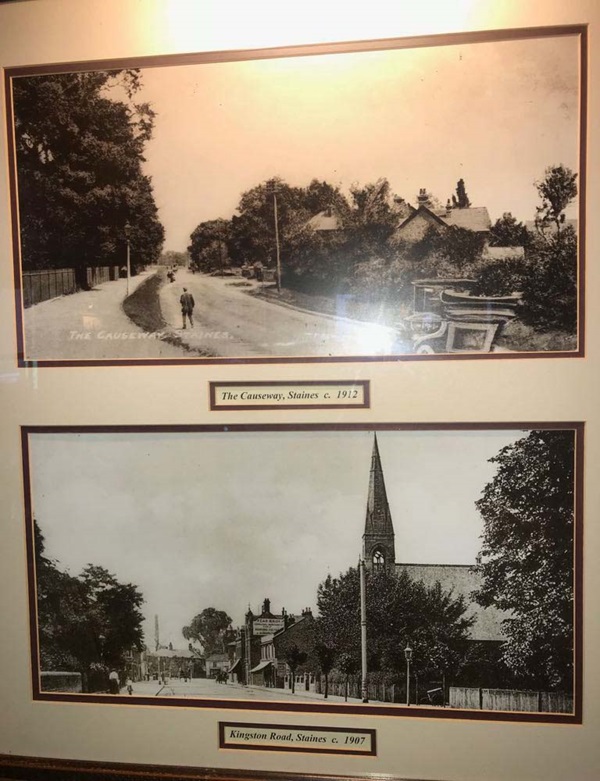
Top: The Causeway, Staines c1912
Bottom: Kingston Road, Staines, c1907.
Photographs of the Market Square, Staines.
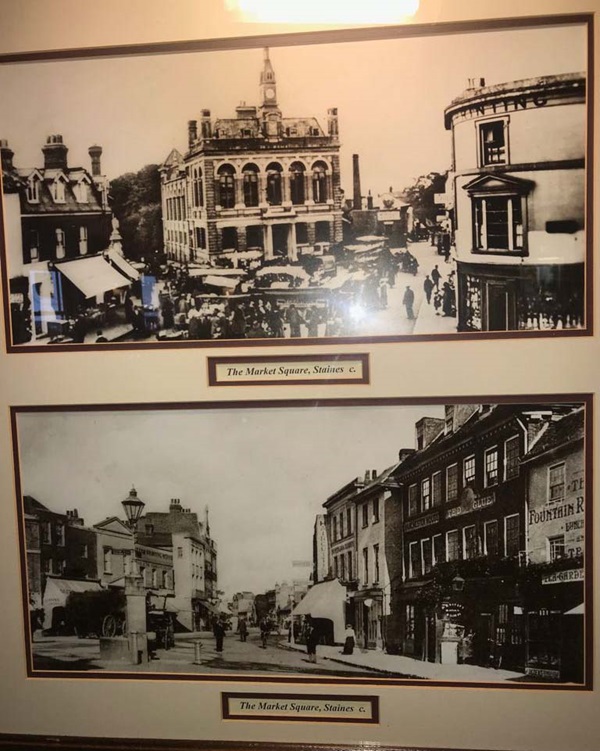
Photographs of High Street.

Top: High Street, Staines, c1905
Bottom: High Street, Staines, c1915.
A photograph of the railway station, Staines, c1905.
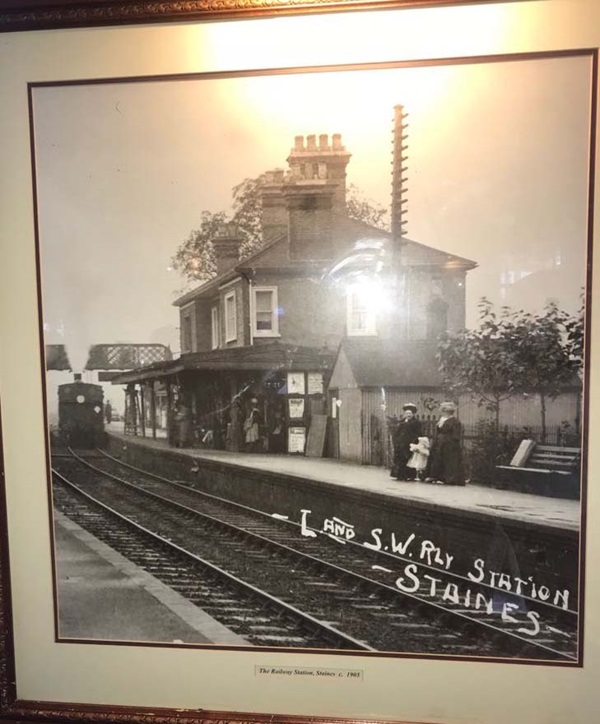
External photograph of the building – main entrance.
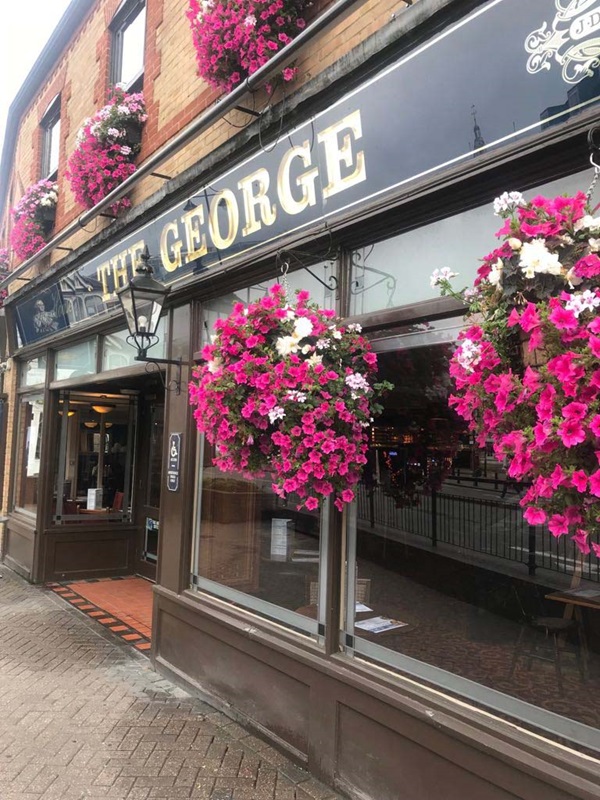
If you have information on the history of this pub, then we’d like you to share it with us. Please e-mail all information to: pubhistories@jdwetherspoon.co.uk